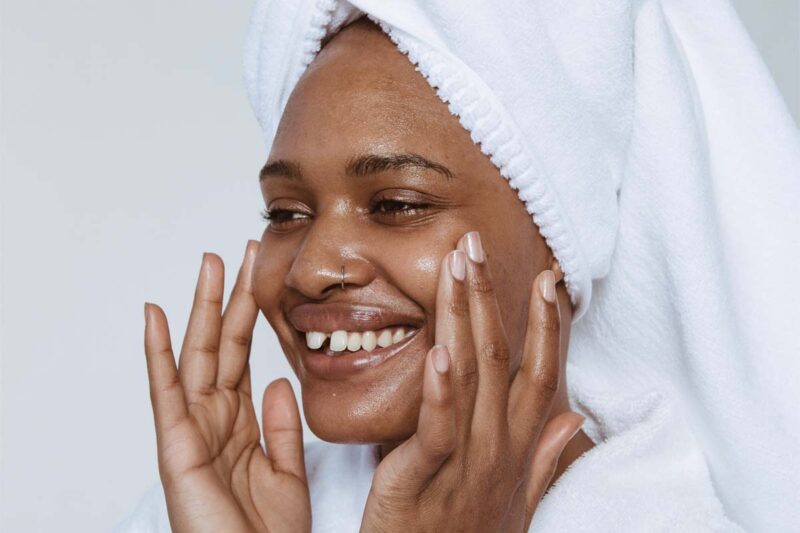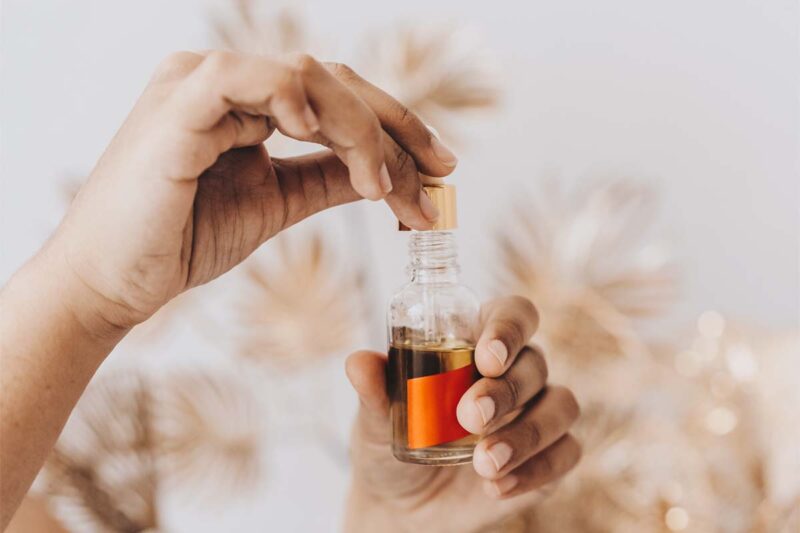Table of Contents[Hide][Show]
Serums and facial oils (moisturizers) are important in any skin care routine. Both are necessary for achieving a beautiful complexion, as they can really change the look and feel of your skin.
We’ll go more deeply into the similarities and differences between a face serum versus a moisturizer (or facial oils) below. Both are necessities to help your skin look glowy and young. We do want to note that we use face oils and facial moisturizers interchangeably. Moisturizers are a skin care product category and facial oils are a specific type of facial moisturizer. We love how nutritious facial oils are and how amazing they are for the skin, so you’ll notice that we refer to this specific type of moisturizer below.
What Is a Serum and Moisturizer?

A serum is a lightweight formula, usually thin and absorbent, that leaves little to no residue on the skin surface after you apply it. Due to how deeply they can deliver nutrients, serums often have various potent, activated ingredients that help you tackle your biggest skin concerns and achieve results like anti-aging, skin brightening and others.
A moisturizer is a thick formula used to lock in hydration and prevent the skin from drying. Moisturizers enhance the topmost skin layer by helping it retain moisture. Some have ingredients that address skin concerns like harm from excessive sun exposure or the appearance of fine lines and wrinkles, but it’s always better to use a quality face serum with your quality facial oil to target these issues.
Are Serums and Moisturizers the Same?
The main similarity between face serums and moisturizers is that they both benefit the skin but in varying functions. A serum provides hydration dealing with the deeper skin level. An oil provides moisturization dealing with the topmost skin layer. That’s because serums contain thinner molecules compared to moisturizers’ larger molecules.
Do I Need Both Serum and Moisturizer (Facial Oil)?
Yes, using both a serum and facial oil in your routine provides numerous benefits. Serums contain a high concentration of active ingredients that get delivered to your skin when you apply them. Different serums perform different functions, from brightening the face to hydrating it. Due to its high aqueous content, serums easily absorb into the skin fully hydrating your skin, unlike creams or oils. Most serums also contain antioxidants that protect the skin from environmental stressors, so you can keep your skin looking healthy and enhance its natural defenses.
A facial oil prevents the skin from being too oily or too dry. When you apply facial oil to a dry face, it helps the skin get back to a supple, dewy state and prevents premature aging. For oily skin, excess oil production is often due to the skin feeling stripped or insufficiently moisturized. That’s why the skin feels the need to overproduce sebum to moisturize itself. When you apply facial oil to an oily face, the facial oil balances the skin’s natural oils.
So, to maintain healthy, well-hydrated skin, both a serum and an oil are necessary for your skin care arsenal. After cleansing and toning your face, apply your serum, facial moisturizer/facial oil, followed by sunscreen. The serum will target your specific skin concerns, while the moisturizer will enhance the serum’s job by locking the hydration in.
What Is the Difference Between a Face Serum and a Moisturizer?

- Size and texture: Face serums are thinner in weight/texture, since they have smaller molecules. In contrast, moisturizers are richer and thicker.
- Performance: Face serums hydrate and are used to target specific skin conditions. That’s why they contain active ingredients and sink deeply into the skin. On the other hand, while moisturizers also provide nutrients to the skin, they do so at the skin’s surface. Facial oils moisturize and lock in the benefits of the serum by creating a fortified seal.
- Skin sensitivity: Since face serums have the ability to be absorbed deeply into the skin, they can potentially cause irritation for those with extra sensitivities. We offer our Probiotic Serum With Tremella, which is great for sensitive skin types. However, if your skin works best with minimal ingredients, a gentle facial oil formulated for sensitive skin may be your best option. Take a look at our Soothe Collection for sensitive skin, which features our essential oil free Herbal Facial Oil for Sensitive Skin.
Which Is Better, Oil/Moisturizer or Serum?
Both products are equally necessary, but vary in what they do for the skin. With smaller molecules and loaded with nutrients, serums hydrate and deliver potent, beneficial ingredients into the skin. If you’re trying to overcome specific skin concerns, use a serum with ingredients that target and eliminate those issues.
On the other hand, a facial oil/moisturizer is excellent for providing deep moisturization to the skin. A good moisturizer seals in water, like an impermeable barrier, so the water doesn’t evaporate from the skin. You don’t want the water to escape from the skin, which results in dryness and the problems that come with it. Most moisturizers contain nut and seed oils that can vary in feel/weight depending on the ingredient and they possess wonderful moisturizing properties for the skin. If you have oily skin, there are specific facial oils designed precisely for your skin type. (You’ll want to use a facial oil that works in harmony with your skin’s natural oils). Oily skin can be fickle, so if you’re struggling to find a product that works, check out our Herbal Facial Oil for Oily Skin and apply it after your face serum.
If you have normal or dry skin, use products in this order: cleanse, tone, apply serum, moisturize with a facial oil of your choice, then apply sunscreen. You’ll want to apply the serum before your facial oil in order to lock in the serum’s active ingredients. When applying your skin care products, a good rule of thumb is to always start with the ones that are thinner in texture and finish with the thicker ones.
Ultimately, you’ll want to incorporate both serums and moisturizers into your routine for the best results, as they work in synergy to achieve youthful skin.
Conclusion
Now that you know the difference between these two products, try adding them to your daily self-care routine depending on your skin type (read on more about how to determine your skin type). All skin types will benefit greatly by using both a serum and facial oil (moisturizer). These products work hand in hand to enhance each other’s purpose and ensure that your skin remains plump and beautiful.
If you’re unsure where to find a serum or moisturizer made with high quality ingredients that are consciously crafted and safe for you, take a look at our collection of moisturizers and serums from Annmarie Skin Care. All of our products are handcrafted with organic and wildcrafted ingredients, so that you can get radiant results without any of the harmful, synthetic chemicals.
Frequently Ask Questions
How long should serum be set before moisturizer?
Serums are primarily thin and absorb easily into the skin. Even though there is no magic number for waiting, it shouldn’t take more than 1-3 minutes for a quality serum to set into the skin.
Can you use serum and moisturizer together?
Yes, you can. In your skin care routine, you will cleanse, tone, apply serum, then a moisturizer and finish off with sunscreen. If you are looking to further the benefits of your serum and moisturizer for the ultimate beauty boost, take a look at our Concentrated Boosting Elixirs, which allow you to enhance your existing routine!








Leave a Reply